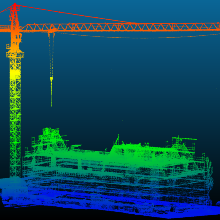The Cluster of Excellence IntCDC (Integrative Computational Design and Construction for Architecture) (https://www.intcdc.uni-stuttgart.de/) of the University of Stuttgart aims to rethink design, fabrication and construction in order to tackle the current challenges of the building industry, such as the lack of sustainability and productivity.
One of the research activities within this interdisciplinary project is the development of a cyber-physical construction platform for automated on-site assembly of prefabricated building elements (https://www.intcdc.uni-stuttgart.de/research/research-projects/rp-8/). Figure 1 shows how an automated tower crane will work collaboratively with a robotic partner system in order to perform this task.
In cooperation with the Institute for System Dynamics, the control for the automated tower crane and the corresponding monitoring system will be developed and tested on a crane at our test site. The goal is to develop a fully automated load handling including the pick and place processes and the transportation in between. Therefore, task scheduling, path planning and an online feedback for collision avoidance during transportation are needed.
Monitoring the construction site at different scales is essential for all these tasks. That is why we are developing methods to monitor the complex, unstructured environment of construction sites with cameras and laser scanners with focus on load monitoring, workspace monitoring for path planning and progress monitoring for task scheduling. While the first two tasks are mainly focused on deriving 3D geometry, the last task requires the semantic interpretation of the data. Such a semantically segmented 3D model of the construction site allows comparisons with planning data and thus the derivation of information about the construction progress.

Norbert Haala
apl. Prof. Dr.-Ing.Deputy Director

Vincent Reß
M.Sc.Research Associate



